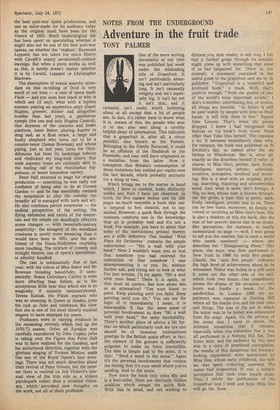Adventure in the fruit trade
TONY PALMER
One of the more moving documents of our time was published last week under the misleading title of Grapefruit. It isn't particularly amusing and isn't particularly long. It isn't unusually weighty and isn't especially big. It isn't fat yet it isn't thin, and it really worth bothering certainly isn't about at all except that a lot of people are. In fact, it's rather hard to know what it is. Aware of this, the people who sent it to me, also sent along a terribly helpful sheet of information. This indicates that a grapefruit is, after all, a citrus paradisi, also known as the Pomelo. Belonging to the Family Rutaceae, it could be an offshoot of the Shaddock or the Pummelo, and may well have originated as a mutation from the latter. Now it transpires that Britain's consumption of these mutations has trebled per capita over the last decade, which probably accounts for a thing or two.
Which brings me to the matter in hand which, I have to confess, looks distinctly unlike any fruit I have yet observed. In truth, its five square inches and its 200 pages so much resemble a book that one is tempted to feel cheated, not to say misled. However, a quick flick through the contents comforts one in the knowledge that all is probably well and it's not a book. For example, you have to admit that some of the instructions printed therein are a trifle definitive. One headed 'Wall Piece for Orchestra' contains the simple exhortation — "Hit a wall with your head." Now I wouldn't want you to feel that somehow you had misread the instruction or that somehow I was misrepresenting it to you. So, without further ado, and trying not to look at what I've just written, I'll try again. "Hit a wall with your head." There it is again, so that must be correct. But how about this as an alternative? "Use your blood to paint. Keep painting until you faint. Keep painting until you die." You can see the logic of it immediately; I mean, it is inescapable. It has the same sense of personal involvement as does "Hit a wall with your head," the same inevitability. There's another piece of advice a bit fur ther on which particularly took my eye and should be of immense international prestige to the British space effort; in fact, the essence of the gesture is sufficiently poignant to make its force irresistible.
The idea is simple and to the point. It is this: "Send a smell to the moon." Again it's the personal involvement that counts; the feeling that it's your smell which you're sending. And to the moon.
Now since the book only costs 40p and is a best-seller, there are obviously hidden qualities which escape the quick flick. With this in mind, and not wishing to distress you, dear reader, in any way, I felt that a further grope through its entrails might come up with something that none of us had bargained for. There is, for example, a statement contained in the useful guide to the grapefruit sent me by th publisher. "Grapefruit is a beautiful and profound book," it reads. Well, that's positive enough; "from the genius of one of the world's most important artists." 1 don't remember contributing but, of course, all things are possible. "In future it will be used widely by people with time on their hands. It will help them to live." Signed John Lennon. That's when the penny dropped. I knew I had recognised the bottom on the book's front cover. None other than Yoko Ono herself. This explains a lot. It becomes immediately clear why, for instance, the book was published on St Swithin's day, so named after the old bishop of Winchester. She is, after all, exactly as she describes herself (I refer, of course, to Miss Ono), petitee, dark, lively, intelligent, married, artistic, articulate, sensitive, perceptive, involved and involving. She is a soul with an original, probing, searching, inquiring and untrammelled mind. And what is more, she's foreign, A Nip, no less, whose bum is known throughout the globe, a bum that is petite, dark, lively, intelligent, artistic and so on. There can be few bums, moreover, as deeply involved or involving as Miss One's bum. She is also a thinker; of this the book, like the rest of her oeuvre, leaves one in no doubt. Her perception, for instance, is neatly summarized on page — well, I was going to tell you the number, but in such a world who needs numbers? — where she describes her " Disappearing Piece." This piece, she says, was first performed in New York in 1966 by only five people. Clearly, the only five people' indicates the high level of achievement about to he witnessed. Water was boiled in a still until it came out the other side of the still, which took two hours. One immediately senses the drama of the occasion — two hours and hardly a break for the sandwiches. In London 1966 the experiment was repeated in Notting Hill where all the blacks live and the race riots and things. The size of the pot in which the water was to be boiled was announced from the stage. Again, it's the privacy of the event that I want to stress, the intimate sensations that it vibrates, especially when you remember that it was all performed in a Notting Hill flat. Two hours later, and the audience by this time was in a state of perplexed anticipation, the results of this dangerous but forwardlooking experiment were announced by Miss Ono, whose early childhood, she tells us, was spent collecting seaweed. The water had evaporated. It was a miracle perception that took your breath away. Thus I salute the publication of the Grapefruit and I wish and hope Miss Ono will go far. Soon.










































 Previous page
Previous page